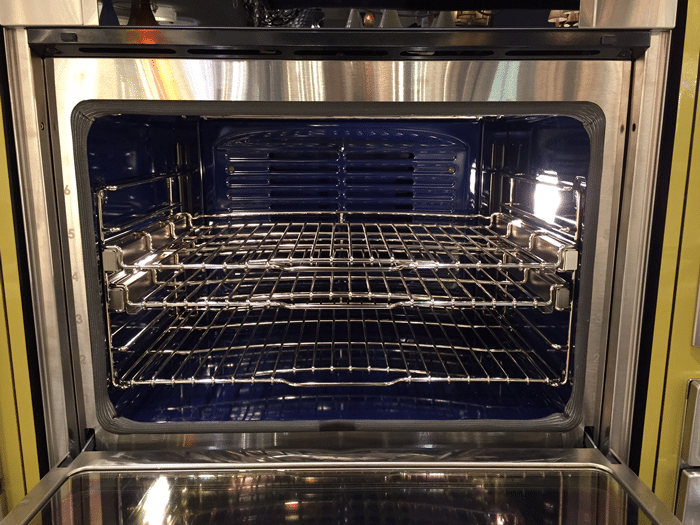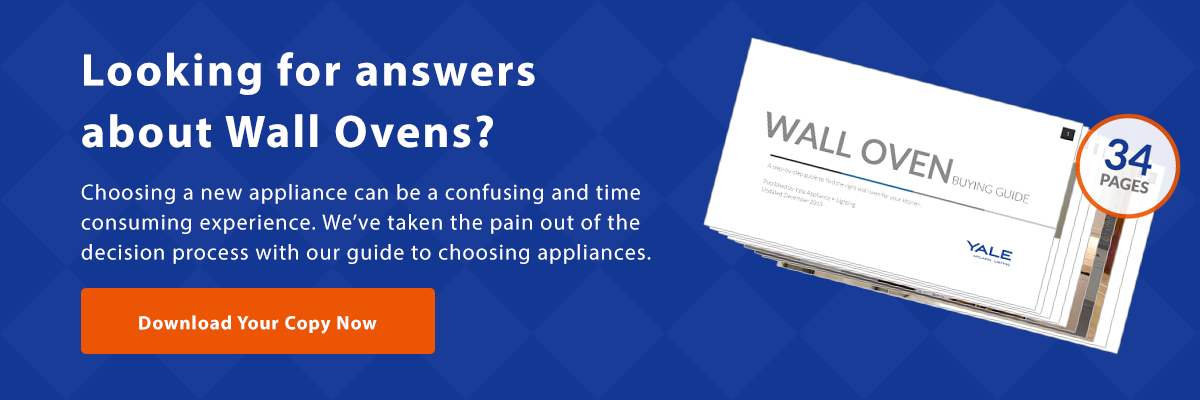If you find yourself in the market for a range or wall oven, there is a pretty good chance that you will be considering models with some sort of convection system in the oven cavity.
If you are unfamiliar with convection cooking, here it is in a nutshell.
Standard Ovens

In a standard radiant oven, air moves around the food randomly, creating hot and cold spots. The results are usually a bottom that is burnt to a crisp, while the tops are almost raw.
Convection Ovens

Convection systems have a fan built in the back wall of the oven that circulates air around the cavity resulting in quicker and more even cooking. European or True convection add a third heating element behind the fan. The tops and bottoms come out as they should, no matter how much or how little you are trying to cook at once. Moreover, you will no longer need to consider rack placement or having to switch/rotate your pans throughout the cooking process.
You can cook everything in a convection oven that you can cook in a standard radiant oven. However, it is important to note that there is a bit of a learning curve with convection, as you will be reducing time by about 25% and/or setting temperatures about 25 degrees less than a standard radiant oven (known in the cooking world as the “rule of 25’s”).
Convection cooking will help jump start the chemical reactions in food and create more flavor while retaining more of their natural juices. The skin of a chicken will render its fat and brown quicker. The sugars in roasting vegetables begin caramelizing sooner creating crisp edges while maintaining moist interiors, thus, creating deeper flavors. Baked goods have flakier crusts because the ingredients have less time to fuse during the cooking process. You will even notice your meats to have a higher yield, meaning they will not shrink nearly as much during the cooking process.
All this being said, not all convection systems are created equal. Single fan systems do a much better job at moving air than a standard radiant oven, but they are not perfect. There will still be some hot and cold spots.

So what about dual convection fan systems? Does having multiple fans circulating the air around the oven cell create the perfect environment? Most manufacturers would probably say that it is more than sufficient. There is one, however, who has taken dual convection a step further.
Wolf's New VertiCross Convection
Wolf’s new wall ovens, the M series, incorporate the latest advancement in convection cooking technology, the Dual VertiCross Convection System. While still using two fans, they have pushed them from the center of the back wall of the oven to the corners and have transformed them into columns. They also reconfigured the heating elements to run parallel with the fans. As a side benefit, this system has also allowed Wolf to create more useable space in the oven cavity without changing the footprint of the unit (4.6 to 5.1 cubic feet to be exact).

The airs “flight pattern” in a single or double fan system are going to have the air forced from the back middle of the oven and circle around the items being cooked. It is a rather scattered proccess and does have its inefficiencies, especially in the corners of the ovens. Dual Verti-cross technology has two full length vertical fans on either side of the back wall pushing the air from the side walls, reflecting off the front glass, and then back towards the middle of the back wall. Running parellel to the fans system are two heating elements, keeping with the European or True convection system Wolf has always delivered on.
Overall, the result is a much more complete uniform process that does a superior job of heat saturation that will minimize cool spots and improve the consistency of multi-rack cooking overall.
The M Series ovens are a big launch for Wolf as they have been running the legendary L series oven for the better part of 13 years without an upgrade. The ovens are all well designed and feature-packed with the new Wolf Gourmet.
However, I believe the new dual verti-cross convection system to be the highlight of the new oven series. The added oven capacity, greater efficiency, and even multi-rack cooking are sure to be a well-recieved additions for consumers.
Let's just hope they don’t wait another 13 years for the next reinvention.
Recommended Reads
Additional Resources
Get the Yale Wall Oven Buyers Guide with new features from Dacor, Miele and Wolf, specs and inside tips to every worthwhile brand. Over 90,000 people have read and learned from a Yale Guide.

Why Should You Trust Us?
It seems that every appliance review has nothing but glowing comments about almost every product, yet you read customer reviews and they are almost universally bad.
We are here to fill in the disconnect. We'll give you the best features, and the drawbacks as well, including reliability based on over 37,000 calls performed by our service team just last year. Our goal is to give you ALL the information so you know what's right for you.
Please consider subscribing or adding to the conversation in the comments below. We appreciate you stopping by.
Jonathan Beresford
Jonathan Beresford is an Appliance Sales Consultant at Yale Appliance. Jonathan has over 12 years of sales experience and prides himself over his superior customer service. In his free time, he likes to spend time with his family and play golf.





